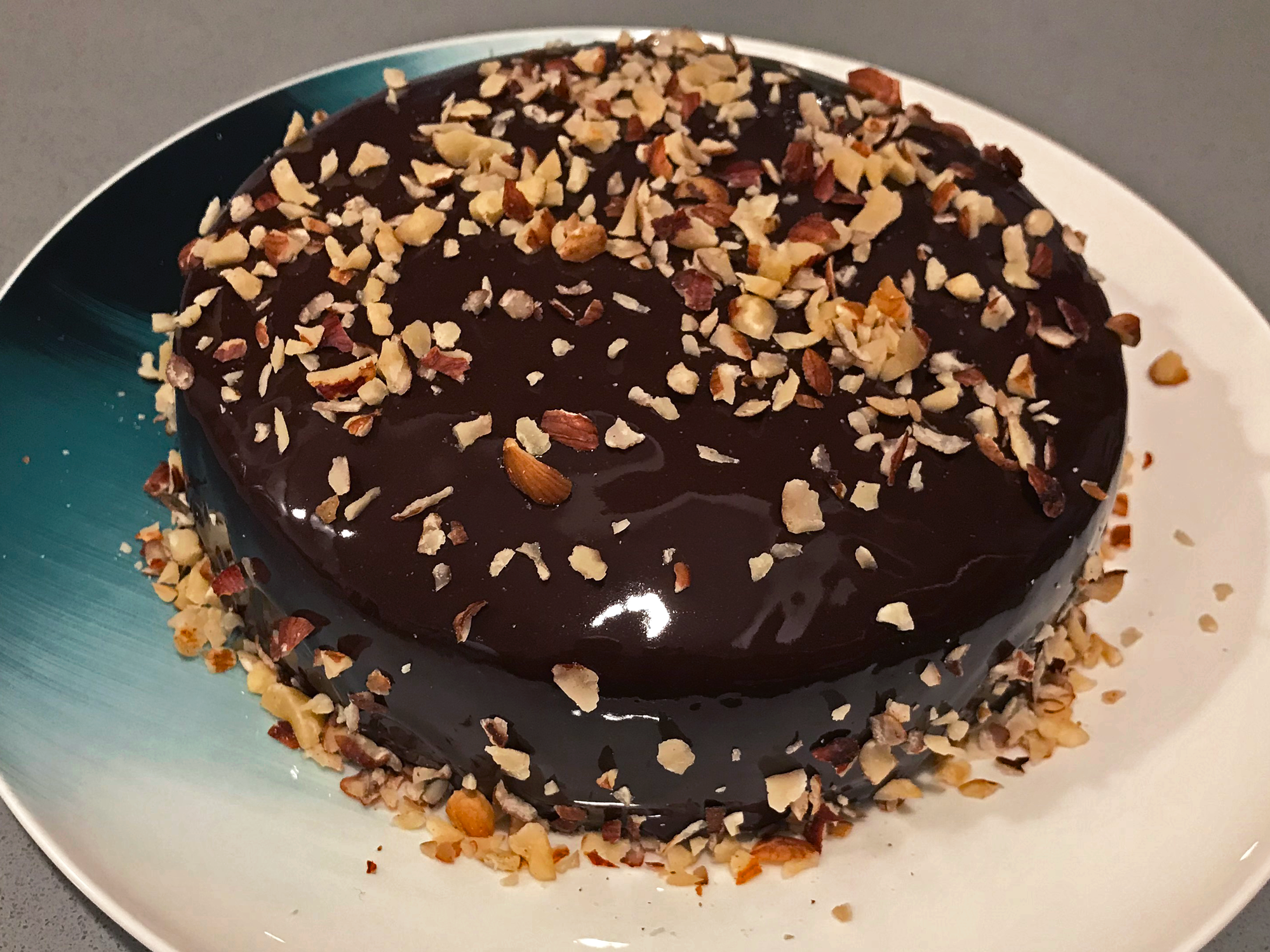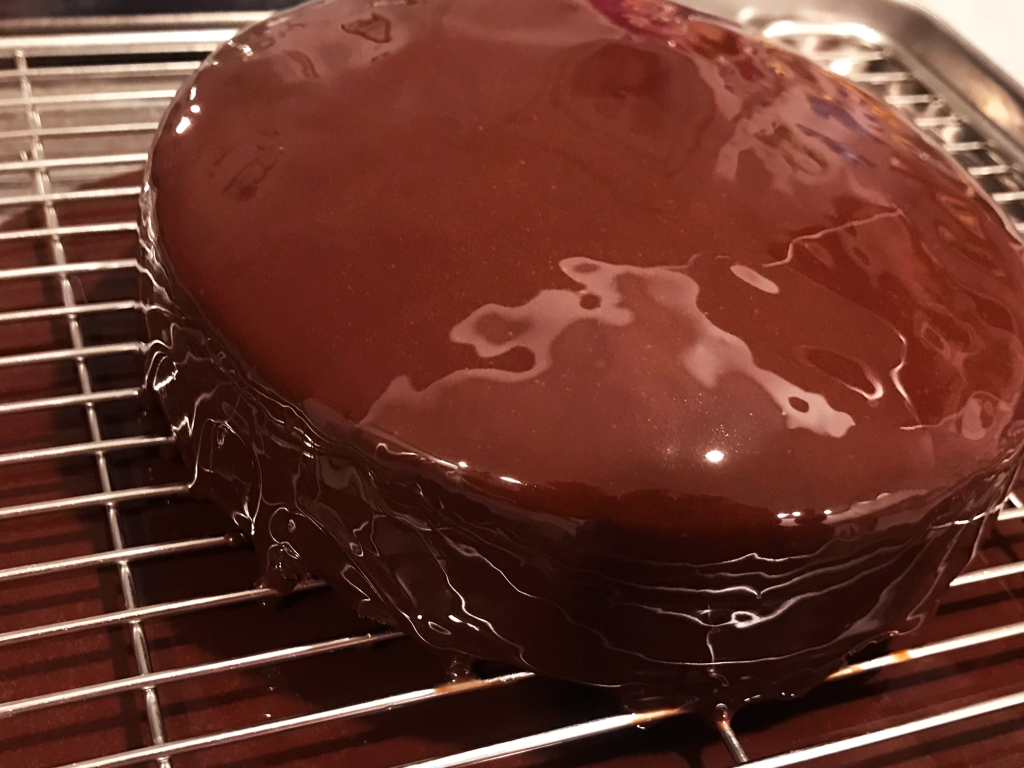Chocolate Mirror Cake

Mission accomplished: a mirror-glazed cake has been a goal of mine for quite some time. The glaze itself is quite rich, so a light and fluffy chocolate genoise sponge pairs well. It can also be soaked for more flavor (think orange-rum or malt). Also consider multiple layers with a chocolate mouse between and on top. Frosting the top smoothly is important so you get a very smooth shine. I adorned my cake with chopped hazelnuts.
Chocolate Genoise Cake
- Prep Time: 20m
- Cook Time: 20m
- Total Time: 40m
- Yield: 1 cake
- Category: Baked, Dessert, Remixed, Vegetarian
Ingredients
- 45 g All-purpose flour (~1/3 cup + 1 tbsp)
- 35 g Cocoa powder, high-quality (~1/4 cup)
- 4 Eggs, cold or at room temperature
- 100 g Granulated sugar (~1/2 cup)
- 45 g Butter, hot and melted (~3 tbsp)
Instructions
- Preheat the oven to 340°F. Grease a 7" or 8" baking pan and line the bottom with parchment paper.
- In a bowl, sift the flour and cocoa powder together three times.
- Place the eggs in a heat-safe mixing bowl (this will be the top of a double-boiler setup). Add the sugar to the eggs in doses while whisking. You must whisk immediately and continually to avoid lumps.
- While whisking, warm the mixture to around 100°F and until it gets foamy. It should be warm to the touch but not hot. Don't overheat or you'll end up with sugary scrambled eggs.
- Remove the mixing bowl from heat. Beat using hand-held electric beaters on high speed until the mixture triples in volume. The bubbles will disappear and appear quite smooth. Don't over mix.
- Turn the mixer down to low and beat for at least 1 more minute just to stabilize the air bubbles in the batter (since there's no rising agent in this recipe, these bubbles are the rise!)
- Sift in 1/3 of the flour/cocoa mixture and gently fold using a rubber spatula until almost fully combined. Sift in the remaining flour/cocoa mixture in 1/3 increments and fold until no flour pockets are visible. I use a "stir around the side and cut through the middle" technique. Don't stir more than you need to or you'll end up with a flat, dense, un-risen cake -- folding releases the air bubbles.
- Add the hot, melted butter to the batter by pouring it down the size of the bowl around the outside of the cake. Fold a couple times to combine. If you pour it in the middle, it'll just sink to the bottom and be hard to combine with fewer strokes.
- Transfer the cake batter into the baking pan. Tilt the pan so the batter spreads out evenly and drop it two to three times on the counter-top to burst the uneven air bubbles. I have used porcelain Corningware bake dishes with success, however drop them onto a magazine from about 1" high.
- Bake on the middle rack for 15 to 20 minutes until the cake springs back when touched gently, and a skewer inserted into the center of the cake comes out clean.
- Let the cake cool completely in the pan before frosting or decorating (or it'll melt off).
Chocolate Mirror Glaze
- Prep Time: 15m
- Cook Time: 10m
- Total Time: 2h 30m
- Yield: One 3-layered 6" cake
- Category: Dessert, Ingredient, Remixed
Ingredients
- 100 g Sugar (1/2 c)
- 70 g Heavy cream (1/4 c + 1 tbsp)
- 6 g Gelatin, powdered (1 0.25 oz packet)
- 30 g Water, cold (2 tbsp)
- 75 g Water, room temperature (1/3 cups)
- 35 g Cocoa powder (3/8 c)
Instructions
- In a small bowl, dissolve the gelatin in 30g (2 tbsp) of cold water.
- In a medium pot, bring sugar and heavy cream to a boil over medium heat, whisking until the sugar dissolves.
- In a bowl, combine 75g (1/3 cup) room temperature water with the cocoa powder. Stir with a spatula until it becomes a uniform paste.
- Whisk the bloomed gelatin into the warm cream-sugar mixture until dissolved, then whisk in the cocoa powder paste until combined.
- Remove the pot from the heat and pour the glaze mixture through a fine mesh strainer over a heatproof bowl to remove any clumps of undissolved cocoa powder. Emulsify the mixture with a hand blender to remove any lumps, until smooth.
- Cover and chill in the fridge. The ideal pouring temperature is somewhere between 86 and 95°F. If you are glazing soon, chill to that temperature range and use immediately. Or you can chill until ready to use (preferably overnight).
- If chilled overnight and ready to glaze, heat it in the microwave until it is somewhere between 86 to 92°F. It should be liquid and pourable. If it looks slightly separated or has lumps from setting, blitz it with a hand blender. Be sure to tap the container a few times to eliminate any bubbles from the blending.
- When glazing, place your (nearly frozen) cake on a wire rack over a rimmed baking sheet. Pour in a circular motion from the center out. Be sure there is an even coating and it flows down the sides, thoroughly covering the whole cake. Any drippings can be reheated and used again.
